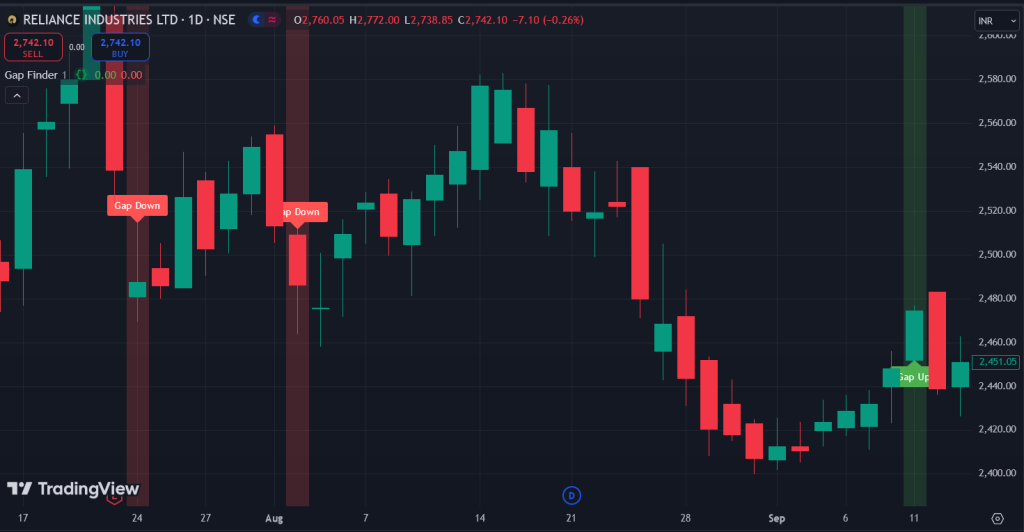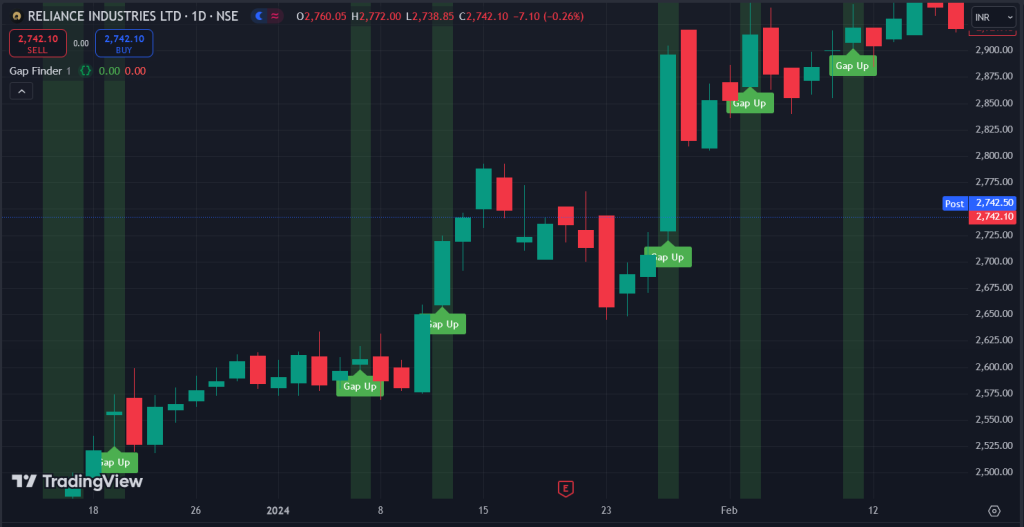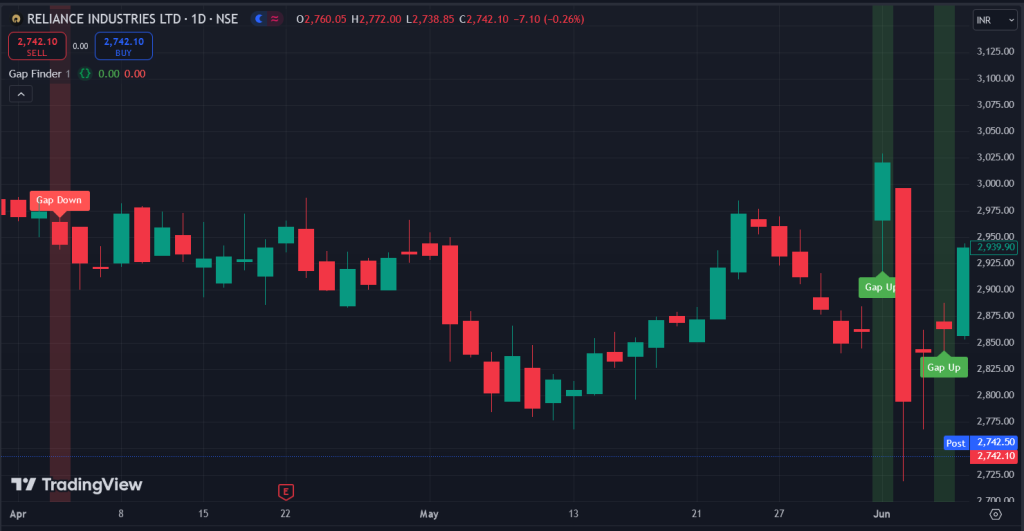🔓 Get All Tools for FREE!
- ✅ Click here to open a trading account using our referral link and start trading.
- 📅 After 7 days of active trading under our referral link, you can get access to all tools in your account.
- ⚠️ Keep trading to keep access free — if you're inactive for 7 days, your access will be removed.
- 👉 Already have an account? You can change the IB (introducing broker) to our referral link ( https://one.exnesstrack.org/a/w7syl3vnjb ) and still qualify!
In the world of trading, price gaps are pivotal moments that often indicate shifts in market sentiment. These gaps occur when there is a significant difference between the previous day’s closing price and the next day’s opening price, potentially leading to major trading opportunities. Spotting these gaps manually can be challenging, which is why the Gap Finder indicator is a powerful tool to help traders quickly identify and capitalize on them. In this guide, we’ll explore what price gaps are, how the Gap Finder indicator works, and how to effectively use it to enhance your trading strategy.
What is a Price Gap?
A price gap occurs when a stock or asset opens at a price that is significantly different from the previous closing price. This often happens due to market-moving news, after-hours earnings reports, or significant economic events that lead to a sharp change in sentiment before the market opens. Gaps can be classified into different types, such as:
- Common Gaps: These are small, short-lived gaps that typically get filled quickly. They often occur in normal trading conditions and don’t usually indicate strong market momentum.
- Breakaway Gaps: These gaps form when an asset breaks out of a consolidation phase or a price range, often signaling the start of a new trend.
- Continuation (Runaway) Gaps: Occurring in the middle of a trend, these gaps indicate that momentum is still strong in the direction of the prevailing trend.
- Exhaustion Gaps: These happen toward the end of a strong trend, signaling that the trend may be losing strength and could soon reverse.
Understanding these different types of gaps can help traders make more informed decisions. The key is knowing how to spot these gaps and distinguish between those worth acting on and those that should be ignored. This is where the Gap Finder indicator becomes essential.
🔓 Get All Tools for FREE!
- ✅ Click here to open a trading account using our referral link and start trading.
- 📅 After 7 days of active trading under our referral link, you can get access to all tools in your account.
- ⚠️ Keep trading to keep access free — if you're inactive for 7 days, your access will be removed.
- 👉 Already have an account? You can change the IB (introducing broker) to our referral link ( https://one.exnesstrack.org/a/w7syl3vnjb ) and still qualify!

The Gap Finder Indicator: An Overview
The Gap Finder indicator is a specialized tool designed to help traders identify price gaps with ease. Instead of manually scanning through charts, the indicator highlights significant gaps on the chart, allowing you to spot them quickly. This saves time and increases accuracy when analyzing trading opportunities. The Gap Finder also allows you to set customizable parameters, making it adaptable to different trading styles and strategies.
Why Use the Gap Finder?
There are several advantages to using the Gap Finder indicator in your trading:
- Efficiency: Rather than manually identifying gaps on a chart, the Gap Finder instantly highlights them, allowing you to make quicker trading decisions.
- Accuracy: It helps to filter out insignificant gaps, reducing the noise in your analysis.
- Customization: The indicator can be adjusted based on your trading strategy, such as setting a minimum gap size or choosing which types of gaps to display.
- Visualization: The indicator uses visual aids, such as color coding and symbols, to make the gaps stand out on your charts.
How Does the Gap Finder Work in TradingView?
The Gap Finder indicator works by automatically scanning your chosen asset’s price history and highlighting gaps that meet specific criteria. The indicator allows traders to fine-tune their settings to suit their preferences and trading strategies. Here’s a breakdown of its key features:
- Gap Size Threshold:
- Traders can define the minimum size of a price gap to filter out insignificant moves. This ensures that only meaningful gaps are highlighted, making your chart cleaner and easier to analyze.
- Gap Direction:
- The indicator can be set to display both upward (bullish) and downward (bearish) gaps. This flexibility allows traders to tailor their strategy depending on whether they are looking to trade long or short.
- Visualization:
- The Gap Finder uses colors or symbols to clearly highlight the gaps on the chart. For example, green markers can represent upward gaps, while red markers indicate downward gaps, helping traders quickly differentiate between the two.
How to Use the Gap Finder in Your Trading Strategy
To maximize the effectiveness of the Gap Finder, you’ll want to integrate it into your overall trading strategy. Here are some tips on how to use it for different trading approaches:
- Swing Trading:
- Price gaps can often signal new trends or momentum shifts, making them ideal for swing traders. For example, if a stock breaks out with a large gap, it could indicate the start of a new trend. By setting your Gap Finder to spot these breakaway gaps, you can find opportunities to ride the new trend over the following days or weeks.
- Day Trading:
- For day traders, gaps often represent key levels of support and resistance. Using the Gap Finder, you can spot gaps at the start of the trading day and look for potential reversal or continuation patterns. Day traders often focus on exploiting these gaps early in the trading session for quick profits.
- Gap Fill Trading:
- One popular strategy is trading the “gap fill,” which occurs when the price moves back to fill the gap created during the previous session. The Gap Finder can help you easily identify potential gap fills, allowing you to take advantage of this common phenomenon in the market.
Example of a Trading Opportunity Identified by the Gap Finder
Let’s walk through an example to illustrate how the Gap Finder can be used in real trading. Imagine a stock that has been trading in a tight range for several days. One morning, it gaps up significantly due to positive earnings news. The Gap Finder instantly highlights this large upward gap.
This gap signals that there’s strong bullish momentum in the market. As a trader, you might decide to enter a long position, expecting the stock to continue its upward trajectory. In this case, the Gap Finder helped you identify the gap quickly, giving you the opportunity to act on it before the price moved further.
Alternatively, you could wait to see if the gap fills, and then consider entering the trade when the price moves back toward the gap.
Best Practices for Using the Gap Finder
While the Gap Finder is a powerful tool, it should not be used in isolation. Here are some best practices for incorporating it into your overall trading strategy:
- Combine with Other Indicators: Use the Gap Finder alongside other technical indicators, such as moving averages or RSI, to confirm potential trades. This will help you avoid acting on false signals.
- Analyze Market Conditions: Not all gaps result in profitable trades. It’s essential to analyze the broader market context and consider other factors, such as news, volume, and economic data, before making a decision.
- Adjust Settings Based on Asset: Different assets behave differently. A gap that is significant for a volatile stock may not be as meaningful for a stable blue-chip stock. Adjust the settings on your Gap Finder indicator accordingly to get the most relevant information.

Pinescript for "Gap Finder"
//@version=5
// insta id algo_aakash
indicator("Gap Finder", overlay=true)
// Input settings
gapSizeThreshold = input.float(1.0, title="Gap Size Threshold", step=0.1)
highlightUpGaps = input.bool(true, title="Highlight Upward Gaps")
highlightDownGaps = input.bool(true, title="Highlight Downward Gaps")
// Calculate price gaps
gapUp = (low > ta.valuewhen(close[1], close[1], 1)) and (low - close[1] >= gapSizeThreshold)
gapDown = (high < ta.valuewhen(close[1], close[1], 1)) and (close[1] - high >= gapSizeThreshold)
// Plot symbols for gaps
plotshape(series=gapUp and highlightUpGaps, location=location.belowbar, color=color.green, style=shape.triangleup, size=size.small, title="Up Gap")
plotshape(series=gapDown and highlightDownGaps, location=location.abovebar, color=color.red, style=shape.triangledown, size=size.small, title="Down Gap")
// Background color to highlight gaps
bgcolor(gapUp ? color.new(color.green, 80) : na, title="Up Gap Background")
bgcolor(gapDown ? color.new(color.red, 80) : na, title="Down Gap Background")
// Labels for gaps
if gapUp
label.new(bar_index, low, text="Gap Up", style= label.style_label_up, color=color.green, textcolor=color.white)
if gapDown
label.new(bar_index, high, text="Gap Down", style=label.style_label_down, color=color.red, textcolor=color.white)

Conclusion
The Gap Finder indicator is an invaluable tool for traders looking to identify and capitalize on price gaps. Whether you’re a day trader looking for quick opportunities or a swing trader aiming to ride new trends, this indicator helps streamline your analysis and improves accuracy. By setting gap size thresholds, focusing on direction, and using clear visual markers, the Gap Finder makes gap trading easier and more efficient.
Disclaimer:
The information provided in this video is for educational and informational purposes only and should not be considered as financial advice. Trading and investing in financial markets carry significant risk and may not be suitable for all investors. Before making any investment or trading decisions, you should carefully consider your financial objectives, experience level, and risk tolerance. Always do your own research and consult with a certified financial advisor. The use of indicators, such as the Gap Finder, does not guarantee profits, and past performance is not indicative of future results.
0 Comments